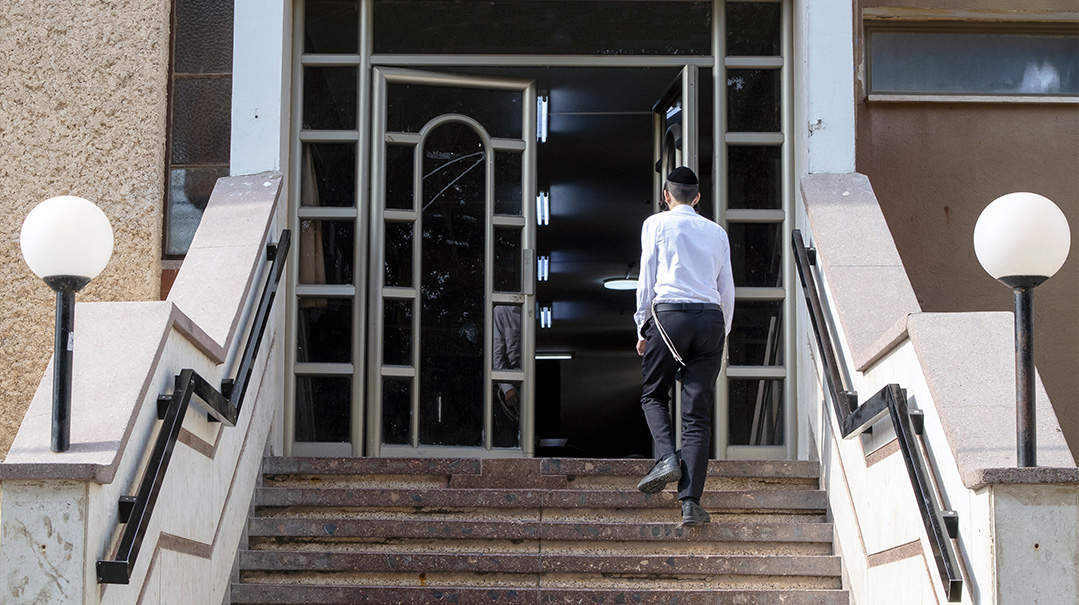Status Symbol
| May 10, 2022Is it in the spirit of “hatzneia leches im Elokecha” to broadcast to the world what we ate for breakfast?
My brother once conjectured that the frum world uses WhatsApp much more than the non-Jewish market. And while, as far as I know, there are no scientific studies on the matter, it’s probably safe to assume that my very affable mailman doesn’t belong to as many WhatsApp group chats as many of us do. Four (okay, twelve) different shul chats, five carpool chats, seven or eight family chats (some with the in-laws, some without), and chesed chats.
There’s the matzah-baking chaburah chat, bungalow colony chats, and the Tehillim chats. And let’s not forget the dormant chats, usually created for a very specific niche purpose, that end up becoming obsolete very quickly.
While there are beautiful communities that are very careful to avoid any form of smartphone usage, the fact is, much of the frum world is using them. And it’s not just professionals and working people. I’m certainly not qualified to discuss the risks posed by these devices, and I won’t. Erliche Yidden the world over continue these discussions and look to their respective rabbanim for guidance.
Smartphone users in the Torah community are perpetually making a risk-reward analysis: Productivity versus Distraction. Chatting versus Children. Real-Life Memories versus Fleeting Megabytes.
Personally, what I find intriguing is the wild world of WhatsApp — or more specifically, the revolution and evolution of the WhatsApp status.
For those who aren’t familiar (the lucky ones among us), WhatsApp is a highly popular texting app that has billions of users worldwide. One of its attractions (and distractions) is the status feature, which allows users to post anything they choose — text or pictures. While in the “yeshivah velt” most mediums of social media are avoided or at least strongly discouraged, WhatsApp statuses have become the go-to social media platform for many in the frum community.
WhatsApp statuses have their own unwritten rules and the many different personalities who post them. There’s the “looking to send two small cantaloupes and one less-small bochur from Brooklyn to Bloomingburg for Shabbos” guy. There’s the “I’m on vacation and you’re not” picture poster guy. One of my personal favorites is the fellow who thinks we’re all looking at his status for our news updates: “Get ready! Blizzard coming!” Or the performer who posted an event where he was featured that was “by invitation only,” apparently to let us commoners know that we weren’t invited.
Then there’s the crying emoji that makes me cringe when I see it posted in reaction to a real tzarah or sad besurah in Klal Yisrael. Something about expressing the tzaar and enormity of a gadol hador passing away or any other tragedy with a crying emoji just seems off to me. But I digress.
New trends bring along new social norms that can leave us confused until we master the nuances.
Someone really should compile a formal WhatsApp etiquette guide. For example, how do you leave a group you never wanted to be added to in the first place? Do I just slip out at 3 a.m. and hope nobody notices, or announce my exit with an explanatory text? Those messages always seem awkward. “Hi all, really been enjoying all the informative discussion about sourdough challah. Hatzlachah with all the starters and antioxidants and stuff.” Yosef has left the chat.
Then there’s the info you shared and wished you hadn’t. Whoever thought of the ever helpful “delete for everyone” should win a Nobel Prize. But can’t they find a way to allow us to delete the “this message was deleted” so all 33 people on the cousins’ chat don’t need to ask me what I deleted? “Sorry, you can ignore that! I was just asking my friend the dermatologist what the dots on Yaakov’s wrist were.”
Recently, I had a personal “aha” moment, and then a “Yidden are just so awesome” moment, that prompted me to write this article.
First, the personal realization: While I don’t use any form of social media, I have WhatsApp and will occasionally feature causes, campaigns, or businesses that are close to my heart on my WhatsApp status. And like most of us, I do take lots of pictures of my family and children. A few weeks ago, after taking a picture I particularly liked, I fleetingly thought of posting it on my status. Then I stepped on the brakes and stopped myself.
Aside from the countless other reasons many of us have for avoiding social media, I presume the most basic among them is that it is anathema to our values to give the world a window into our homes. (And if one just visits social media sites to peruse what others are up to… the yenta-er versus yenta-ing conversation is for a different time.)
Mah tovu ohalecha Yaakov mishkenosecha Yisrael. Rav Yochanan (Bava Basra 60a) says, ‘‘One window should not face the other,” and Rashi explains: “Because of tzniyus.”
We are all products of our surroundings, and I saw myself forgetting that perhaps the digital windows into our private and family lives are most often best left closed.
The hard questions need to be asked and answered: Does everyone need to see our vacation pictures? Is it in the spirit of “hatzneia leches im Elokecha” to be broadcasting to the world what we ate for breakfast? Or the anniversary present we received from our spouse? On that note, does a photo of a married couple as a profile picture fall within the parameters of tzniyus that we cherish? Again, I’m very much not the one to address this — but let’s at least be asking the questions.
Gedolim have and will hopefully continue to share their chochmah with us about this topic — and we will hopefully listen.
And now for the “Yidden are just so awesome” moment. The most amazing thing about our little frum Jewish “WhatsApp-sphere” is how our true colors shine through. We might be emoting, expressing, and communicating on a whole new platform, which at times might feel shallow and unnatural — but the Yiddishe neshamah still comes beaming through that tiny screen display.
Take the challenge: Check your statuses on any given day, and you’re bound to find tzedakah being collected, Sefirah reminders, or chesed being offered. Maybe it’s someone sharing a picture of a holy moment (usually someone whom you haven’t spoken to since tenth grade), but he visited a gadol with his son. Or he cried at the kever of a tzaddik — and he’s proud of it. Look what’s on our minds. (The millennial computer geek sitting in some boardroom in Silicon Valley, who came up with the WhatsApp status idea, might not realize that he created, arguably, one of the greatest tzedakah collecting platforms ever — in addition to all the other amazing stuff we use it for.)
An eiruv tavshilin reminder, a pair of lost tefillin being returned, or maybe someone just sharing a new niggun or inspirational Torah ha’arah…. While this unique form of communication needs to be handled with care, nine out of ten times what we Yidden are broadcasting to the world most is “mi k’amcha Yisrael.”
That is our status symbol.
Yosef Wartelsky is the director of Camp Maaminim in the Catskill mountains. He lives with his wife and children in Far Rockaway, New York.
(Originally featured in Mishpacha, Issue 910)
Oops! We could not locate your form.






